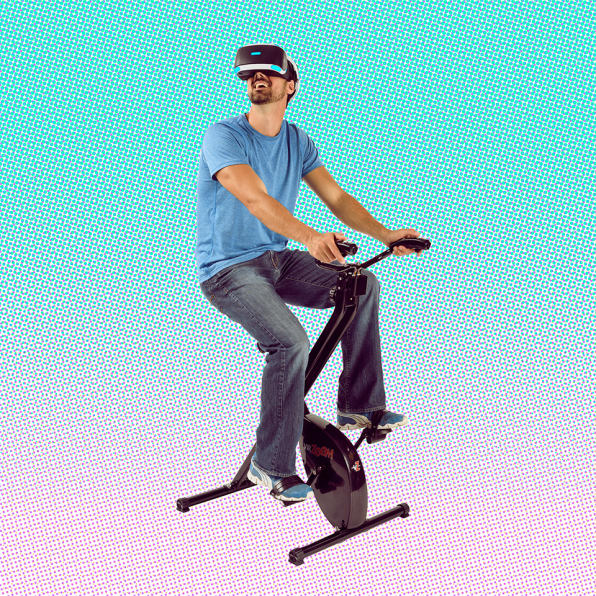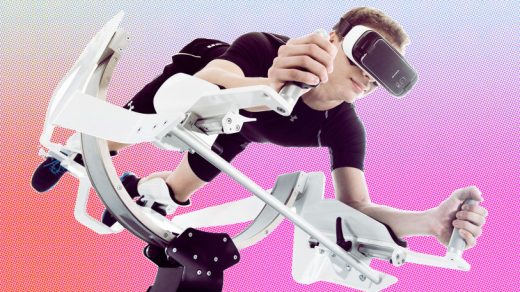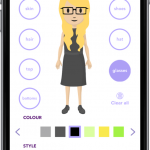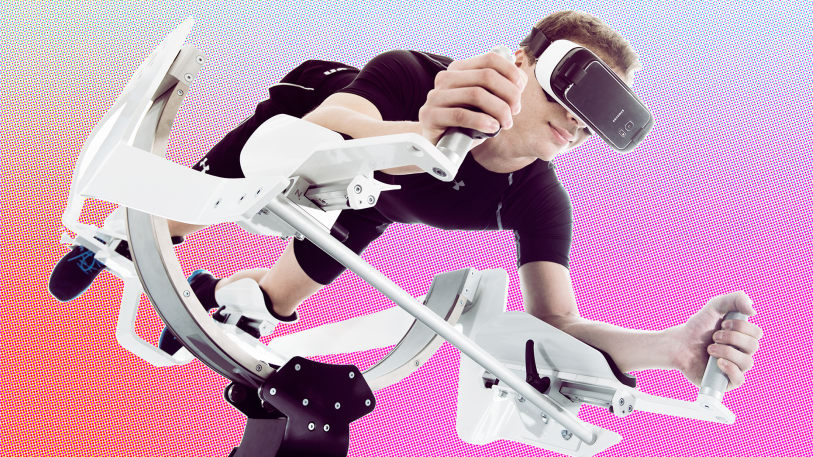These VR Fitness Startups Want To Give You An IRL Beach Body
Imagine driving a tank over snowy terrain, soaring on Pegasus’s wings over idyllic apple orchards, or lassoing bandits on horseback—all just by pedaling a little harder on a bike that’s bolted to the floor.
“You really have to experience it to understand it,” concedes Spencer Honeyman, director of business development at VirZOOM, the maker of a virtual reality (VR) exercise bike and an accompanying athletic video game library. The bike itself weighs less than 40 pounds and began retailing last June for $399 at Amazon and Gamestop. It’s compatible with Playstation VR, Oculus Rift, and HTC Vive headsets, and comes complete with fantastical games that require eager calves and a suspension of disbelief.
“We’re asking [consumers] to make a leap,” Eric Janszen, VirZOOM’s CEO and cofounder, explains of the company’s conceptualized workouts. But once you’re on the VirZOOM bike, he promises, it feels natural.
So I saddled up, strapped on a wireless HTC Vive VR headset, adjusted my headphones, and suddenly found myself astride a white, winged stallion. Honeyman was right—you really did need to see for yourself. I could never have imagined this would be a pleasant way to work out. But here I was, pumping away without even realizing I was moving my legs. My thoughts were exclusively about preventing my sweet Pegasus from plummeting to his death.

If VR fitness can do anything, it can make you stop counting down the minutes of a workout. Of course, fitness gaming is nothing new: Nintendo Wii has been on the market for over a decade, but this immersive experience squashes just about every imaginable distraction. A bike, also, is perfectly suited for activity requiring fast movement in a controlled environment. You’re safely stationary, so there’s no jerking motion that might provoke nausea. I doubt a treadmill or rowing machine would offer the same experience.
Not that coming to such a conclusion was simple for VirZOOM. The Cambridge, Massachusetts–based company said it went through various equipment iterations before settling on the stationary bike. It needed to be comfortable, efficient, and not vomit-inducing. Plus, cycling is fuss-free and, for most Americans with healthy childhood memories, not terribly intimidating. That was imperative for Janszen, who liked the idea of a high-tech exercise solution being as easy as riding a bike.
But plenty of bike owners, as Janszen well knows, never take them for a spin. Ditto for people who sign up for gym memberships and never go, or buy treadmills only to banish them to the garage. If VirZOOM and a growing number of competitors are to succeed in reinventing fitness, they’ll need to get the magic of VR to make exercising feel a lot more fun than it is.

Can Workouts Feel Less Like Work?
According to Janszen, VirZOOM is “not just a more fun way to use an exercise bike—but actually a sport. It’s a way to compete with yourself and to compete with other people.”
The company partnered with Fitbit so users can record their every calorie burned and minute clocked—not just to keep track of their own data but to compare those stats with others’. Whether it’s that competitive spirit or the VR experience itself, something seems to be working. According to VirZOOM’s research, the average time spent on a bike is 26 minutes per session, with users returning for a new session every 23 hours (whereas you get to the gym, what, three times a week?).
VirZOOM isn’t alone in using VR to incentivize exercise. In April, German startup HYVE introduced ICAROS a flying experience simulator, which retails for $8,400. The device—which looks more like a medieval torture apparatus than fitness equipment—targets shoulders, abs, upper chest, and overall body control.
“The experience is based on a physical feeling of balance and unusual motion, since you have to shift your body weight to either lean downward, upward, left, or right,” HYVE’s CEO Michael Schmidt explains via email. With these movements, you steer your flight in one of two games, either soaring through mountains and canyons or diving in a subaquatic abyss teeming with sea creatures.
“Your head movement is free, so while flying, diving, or floating, you can look in any direction [that’s] physically possible,” says Schmidt. “This combination, and the constant body balance, is really putting you into a ‘flight mode.’”
The Fitness Sector’s Sprint Into VR
Michael De Medeiros is the editor of VR Fitness Insider, an eight-month–old site that chronicles that latest in the ever-growing field. He sees all these as just the start of what’s to come. Worldwide revenues for the combined augmented reality (AR) and VR market is slated to climb from $5.2 billion in 2016 to over $162 billion in 2020, according to the International Data Corporation. For the fitness sector, that likely means more equipment, more games, and more widespread adoption by the public.
“As technology evolves, the world of VR and fitness will grow exponentially,” De Medeiros believes, adding we’re roughly two years away from VR fitness being a 360-degree, full-body experience.
Vive Studios, the virtual reality content development and publishing initiative from HTC Vive, is already bulking up its athletic game offerings. The brand’s most popular to date include Knockout League, a boxing game in which you continuously squat to dodge punches, and a tennis game where you sway left and right as you would on the court. Vive Studios releases around 30 games a year, and this year 20% are expected to be athletically driven.
Joel Breton, head of Vive Studios, envisions the company’s catalog appealing to consumers who spend thousands of dollars on a treadmill or rowing machine, only to push it to a corner after a few weeks. “They get bored,” he says. With an incoming rush of new games each quarter, Vive intends to keep them engaged—and fit.
It’s no accident that VirZOOM’s early adopters were gamers, but as PC prices dropped and VR has moved toward the mainstream, the company is going after casual fitness consumers on one hand (Janszen describes VirZOOM as appealing to “the person who buys a gym membership and doesn’t use it”) and casual gamers on the other.
“There is already is a huge number of people who like to work out and who are into fitness,” Breton explains, “and so if we can show them the value of just having fun and maybe gamifying your workout, that’s a fantastic crossover.” According to De Medeiros, the market data backs that up. If you look at gaming outside of VR, he says, there’s enormous opportunity to build a rapid following in a growing market, but that potential has been held back so far by a rather stagnant user experience: “You navigate through these worlds and you live in them,” he explains, “but ultimately you’re still sitting on a couch” with a controller in your hands, staring at a screen.
VR, by comparison, is transportive. And when you’re able to divorce yourself from mundane reality, it’s easier to move without even realizing you are. “It feels natural, unlike pushing a button,” De Medeiros adds, and the competitive element means “you’re not going to be looking at the clock—you’ll be focused on the prize.”

In a 2013 study titled “Mirrored Selves: The Influence of Self-Presence in a Virtual World on Health, Appearance, and Well-Being,” University of Missouri researcher Elizabeth Behm-Morawitz explored how avatars affect people’s perceptions of their fitness abilities.
“By becoming a different person online—or maybe even a better version of yourself through an avatar application,” she explains, “you can then explore a healthier version of yourself” in the real world. Behm-Morawitz found that if you put someone in a virtual environment on a treadmill, they’ll likely set aside time to actually exercise within the next 24 hours. Similarly, leaping high into the air while playing Second Life tends to get players to believe they might be able to do the same in reality.
Behm-Morawitz’s test subjects emerged wanting to incorporate their virtual behavior into real-life actions. The low-risk scenario of role-playing in an idealized environment gave them the confidence to test out such activities in more “high-risk situations”—like real life. It’s unclear whether this kind of role-playing has long-term effects, but it nevertheless motivates them to move, at least temporarily.
The Future Of Fitness–And What’s Holding It Back
There are some issues, however, that plague the budding industry. One involves perceptions. The average consumer is still put off by what looks like a bulky, heavy VR headset and earphones. HTC Vive’s wireless adaptors are not yet widely available but are expected to hit the market this year. With wireless headsets, weight becomes less of a concern, and a signal of industry’s commitment to making the experience lighter and more comfortable.
“The tech that’s out there right now is great,” says De Medeiros, “but the tech that will be out there in two to three years is going to make what’s out there today look like wearing a heavy sack of potatoes on your head.”
Then there’s the issue of whether consumers will want to share sweat-drenched headsets at communal places like the gym. It’s partially why VirZOOM targeted the home market, although, says Honeyman, early testers haven’t seemed to mind. “People are so immersed in this experience, and they have the expectation that they’re gonna sweaty,” he says.
And lastly, some fitness enthusiasts complain that the current VR fitness market caters purely to cardio, ignoring weight-lifting or more resistance training. Medeiros acknowledges that “you’re not gonna get bigger arms through ICAROS,” which is meant as professional device, with targeted clients like gyms, physical therapists, and arcades.
Preston Lewis, cofounder of Black Box, which bills itself as the world’s first virtual reality gym, is less interested in selling individual pieces of exercise equipment than he is in creating a standalone experience. He’s now building an entire boutique gym dedicated to VR resistance-training in Boise, Idaho.
Black Box’s patent-pending resistance system can scale weights up and down elastically. It uses an AI algorithm to track every repetition and progressively increase the intensity. Each equipment system, accompanied by the HTC Vive wireless headset, comes with handles that translate to something in virtual reality, like shooting a gun. “We’re creating a new category of sports,” says Lewis.
Black Box VR is in beta mode through April, but Lewis has high hopes it will resonate with fitness fans looking for a fresh workout alternative. “I couldn’t imagine [a resistance training enthusiast] wouldn’t want to do this,” says Lewis, who finds it especially useful for the challenging monotony of reps. But the effect is much the same as the makers of other VR fitness systems claim: “Once you’re in there, you forget that you’re working out.”

Gym franchises aren’t likely to convert all their equipment to VR, but many may incorporate VR elements in the coming years. VirZOOM recently announced a partnership with LifeFitness, which makes commercial exercise equipment, to pilot a VR solution that can be used with its machines. The hope is to draw in people who might have otherwise taken a SoulCycle class. VirZOOM says it’s been contacted by dozens of gyms in recent weeks that are interested in its equipment. “VR is becoming more mass market,” Honeyman says.
Indeed, the VR customer is evolving; it’s no longer hardcore PC users and tech geeks. Already, a third of VirZOOM’s customers identify as health customers first, saying they buy VR headsets solely to complement their VirZOOM bikes.
In the meantime, VirZOOM is doing all it can to introduce consumers to what it believes is the future of fitness through product demos in arcades and elsewhere. It’s even producing 28 tournaments around the country in 2017, week-long competitions where participants vie for Amazon gift cards. The goal is to acquaint consumers with a product they need to experience in order to get behind.
“It’s truly about getting people on [the bikes],” explains Honeyman. “That’s when you get it.”
Fast Company , Read Full Story
(73)














